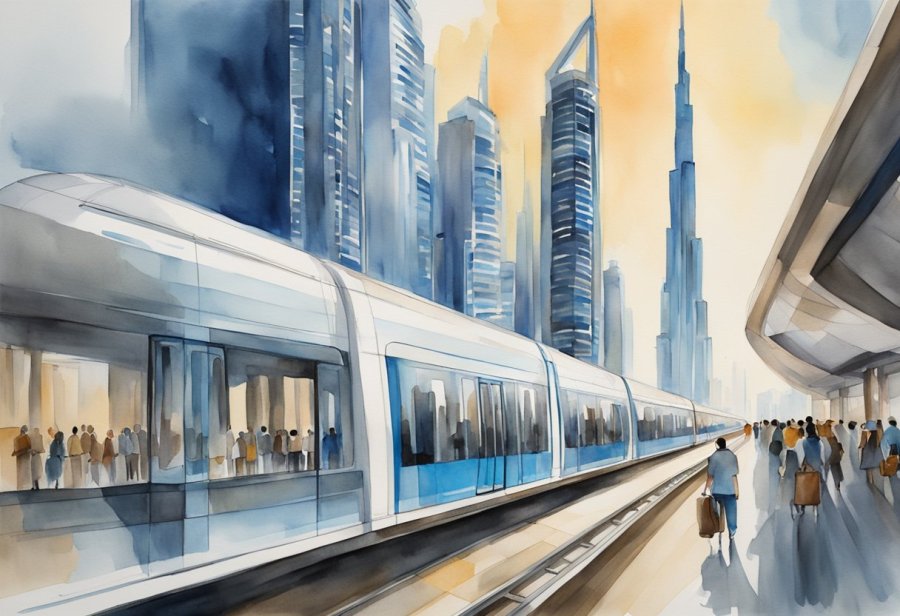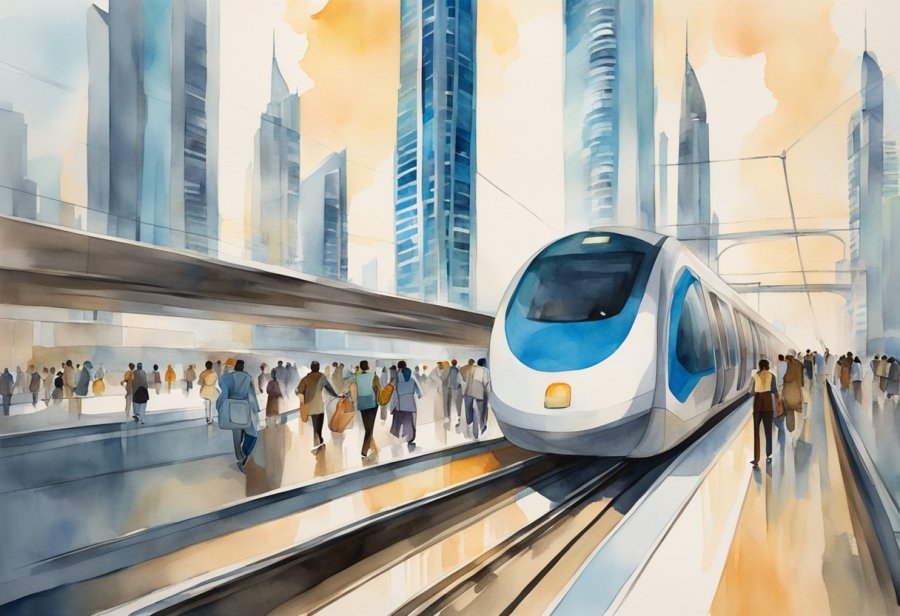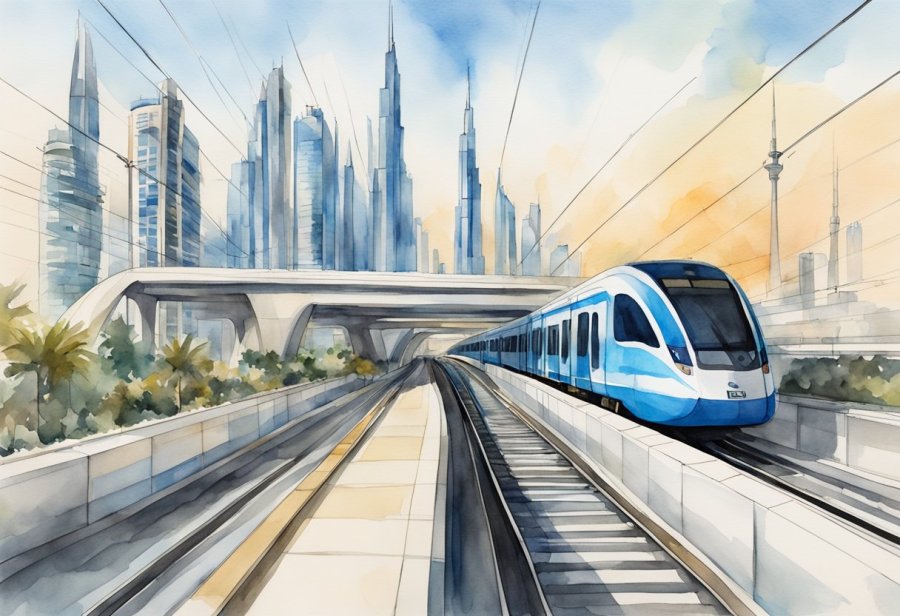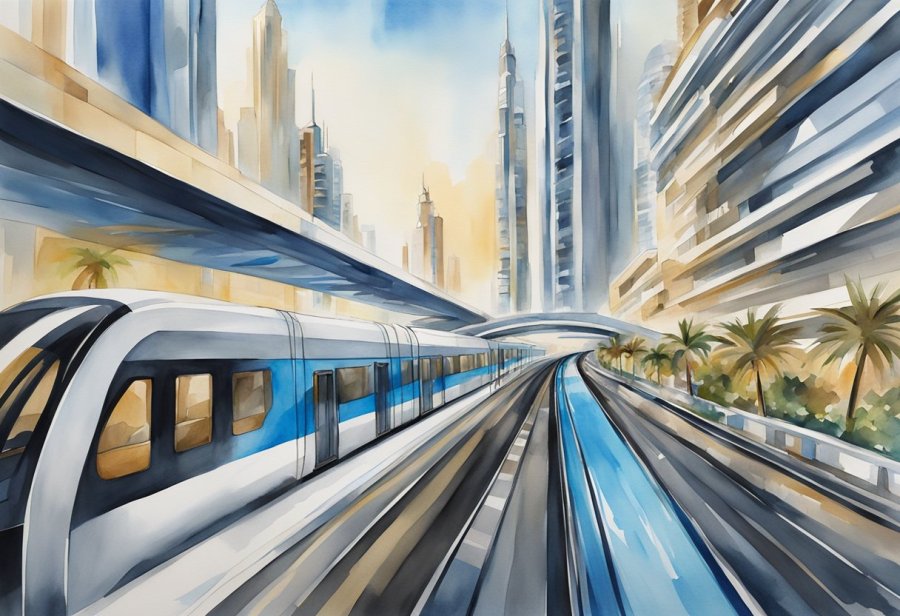Navigating Dubai’s bustling cityscape is made seamless and efficient with the Dubai Metro, the city’s modern rail system. With routes spanning nearly 90 kilometres, the Dubai Metro is a fully automated network that offers travellers and residents a convenient mode of transportation across its comprehensive coverage area. Two primary lines, the Red and Green, serve as the backbone of the system, ensuring that whether one is commuting to work or exploring Dubai’s numerous attractions, there is likely a Metro station nearby to facilitate their journey.
- Overview of Dubai Metro
- Riding the Dubai Metro
- Accessibility Features
- Stations and Connectivity
- Metro Expansion Plans
- Frequently Asked Questions
- What are the operating hours for the Dubai Metro?
- How can one navigate the different stations on the Dubai Metro Red Line?
- What are the ticket prices for travelling on the Dubai Metro?
- Can you explain how to use the Dubai Metro for first-time riders?
- Is there a mobile application available for convenience in using the Dubai Metro?
- What is a Nol card, and how does one obtain and use it for the Dubai Metro?

The detailed Dubai Metro Map is an invaluable tool for users, providing a simplified overview that aids in route planning and fare calculation. It indicates all the stations along both lines and the transport zones they fall into. Riders can thus navigate the system with ease, making it simple to reach destinations such as the Dubai International Airport, the Dubai Mall, and the iconic Burj Khalifa. Additional features of the Metro, like its clean, air-conditioned carriages and frequent service intervals, add to the overall appeal of using the system for daily commutes and casual explorations alike.
The Red Line, in particular, has been enhanced by the Route 2020 extension, which extends from Centrepoint to Expo 2020, thus expanding the Metro’s reach. As described in the comprehensive Dubai Metro Guide, travellers can expect trains to run with remarkable frequency, ensuring minimal waiting time and quicker transit. The level of organization and user-friendliness of the Dubai Metro makes it a prime example of the city’s commitment to providing high-quality public transport options.
Overview of Dubai Metro

The Dubai Metro stands as a testament to Dubai’s commitment to providing modern, efficient urban transportation. It is a fully automated rail system without a human driver on board.
History and Development
Dubai’s quest to enhance its public transportation culminated in the inauguration of the Dubai Metro in September 2009. It marked the city’s rapid progression towards becoming a globally recognized urban centre. Constructed by a conglomerate that included Mitsubishi Heavy Industries, this metro system has continued to expand, paving the way for convenient and speedy transit across the city.
Metro Lines and Routes
The Metro network comprises two primary lines:
- Red Line: A major artery of the network, branching out into two routes at the Jabal Ali interchange.
- Green Line: Running generally parallel to Dubai Creek, this line weaves through the older parts of the city.
Stations:
- Red Line: has a total span of 52.1 km with 29 stations.
- Green Line: covers 22.5 km and includes 20 stations.
Operating Hours
Dubai Metro operates seven days a week but with varying train timings. Typically, operational hours are:
- Sunday to Wednesday: From early morning around 5:00 am to midnight.
- Thursday: The service is extended until 1:00 am of the following day.
- Friday: Starting later in the morning, around 10:00 am, to accommodate the weekend, the service runs until 1:00 am.
- Saturday: Resumes at 5:00 am and runs until midnight.
Please refer to the official RTA Metro Timetable for the most accurate timings, as they may vary on public holidays or during special events.
Riding the Dubai Metro

Riding the Dubai Metro is an efficient way to navigate the city. Passengers can choose from various ticket options, purchase and recharge their Nol cards with ease, and are expected to follow certain rules and etiquette during their journey.
Ticket Types and Fares
Dubai Metro offers several ticket types to cater to different traveller needs. The tickets are categorized into Nol Red, Silver, Gold, and Blue cards, each with its fare structure. The Red Ticket is suitable for tourists and casual users, whereas the Silver Card is a more cost-effective option for regular commuters. The Gold Class offers premium seating at higher fares for those seeking luxury. Additionally, there is a Blue Card, which is personalized and offers various privileges—children under the age of five travel for free.
- Nol Red Ticket: Designed for tourists and occasional travellers.
- Nol Silver Card: Ideal for regular users with standard fares.
- Nol Gold Card: Offers access to Gold Class cabins at a premium fare.
- Nol Blue Card: Provides personalized travel with additional benefits.
Purchasing and Recharging Nol Cards
To travel on the Dubai Metro, passengers must purchase a Nol Card, which can be obtained at any metro station, some bus stations, and online. Recharging these cards is straightforward and can be done via ticket vending machines, authorized sales agents, or online through the RTA website. Passengers should ensure they have sufficient credit on their cards before travelling to avoid any inconveniences.
- Purchase Locations: Metro and bus stations, online.
- Recharge Options: Vending machines, sales agents, RTA website.
Rules and Etiquette
Travelers are expected to adhere to Dubai Metro’s rules and etiquette to ensure a safe and pleasant journey for everyone. Eating, drinking, or smoking is strictly prohibited inside the metro carriages. There are designated cabins for different passenger groups like women and children, and Gold Class ticket holders. It is critical to stand clear of the doors and allow passengers to alight before boarding. Violation of these rules can result in fines.
- Prohibited Actions: Eating, drinking, smoking.
- Designated Cabins: Women and children, Gold Class.
- Boarding Etiquette: Allow alighting passengers to exit first.
Accessibility Features

The Dubai Metro is outfitted with a range of accessibility features to ensure a convenient travel experience for individuals with disabilities. These features are integrated within stations and trains.
Facilities for People with Disabilities
- Lift Access: All metro station levels are equipped with lifts, providing an easy navigation platform for wheelchair users.
- Wheelchair Spaces: Dedicated spaces are available for wheelchair users on all trains, ensuring that passengers with mobility issues can travel comfortably.
- Tactile Guidance Path: For visually impaired individuals, there is contrasting tactile guidance available to help navigate through the stations.
Station Accessibility
- Entry and Exit: Stations are designed to be accessible, with easy entry and exit points for all passengers, including those with disabilities.
- Signage: Clear and visible signage is provided throughout stations to assist passengers in finding their way.
For more detailed information on accessing the metro, visits to Travel Accessibility in Dubai can be beneficial. Additionally, understanding the guide to the Dubai Metro and Tram can further aid in planning a trouble-free journey across the city.
Stations and Connectivity

The Dubai Metro network offers extensive connectivity across the city with key hubs facilitating transfers and accessibility.
Major Stations
Union and BurJuman stations are pivotal for transfers as they serve both the Red and Green Lines. Passengers can easily switch lines to reach a multitude of destinations throughout Dubai. Furthermore, the Route 2020 extension adds notable stations like Expo 2020 to the Red Line, enhancing connectivity to new districts.
Feeder Bus Services
Feeder bus services are integrated with the metro to extend the network’s reach. Buses are timed to metro schedules, providing seamless connectivity from stations such as Al Rashidiya and Mall of the Emirates to nearby localities.
Parking Facilities
Designated parking areas are available at select metro stations. Rashidiya, Nakheel Harbour and Tower, and Etisalat stations offer free parking for metro users, encouraging commuters to utilize the metro by providing convenient parking options.
Metro Expansion Plans

Dubai’s Metro network is on the cusp of a substantial expansion that will see new lines introduced and existing stations receiving significant upgrades to enhance passenger experience and improve connectivity across the city.
Upcoming Lines
The Roads and Transport Authority (RTA) of Dubai has set plans in motion to augment the city’s metro infrastructure with the addition of 12 new stations and an extension of over 20 kilometres. This extensive growth is anticipated to cater to the increasing demand for efficient public transportation in the ever-expanding city landscape. A noteworthy project is the Blue Line, which is projected to cover 30 kilometres, potentially serving around 1 million residents.
Projected Station Upgrades
Enhancements to existing stations are integral to the RTA’s vision, with a focus on innovative technology and passenger amenities. Upgraded stations will feature state-of-the-art facilities designed to streamline the travel process and provide an improved overall user experience. Moreover, these changes are not merely functional but also aligned with Dubai’s futuristic ethos, ensuring that stations meet aesthetic as well as practical benchmarks.
Frequently Asked Questions

Navigating the Dubai Metro system can raise several questions for both locals and tourists. This section aims to clarify common uncertainties such as operating hours, ticket pricing, and usage of the Nol card.
What are the operating hours for the Dubai Metro?
The operating hours of the Dubai Metro vary throughout the week. From Monday to Thursday, trains run from 5:00 am until midnight. On Fridays, services extend from 5:00 am until 1:00 am the following day. Saturday operations resume at 5:00 am to midnight, while Sunday hours are from 8:00 am until midnight. Passengers should check for any special adjustments on holidays or during events.
How can one navigate the different stations on the Dubai Metro Red Line?
Travelers can navigate stations on the Red Line using updated Dubai Metro maps available at all stations, or by using digital resources that detail station locations and connecting services. Information desks and signage within the stations also provide guidance.
What are the ticket prices for travelling on the Dubai Metro?
Ticket prices for the Dubai Metro depend on the number of zones crossed during travel. Prices start at a baseline fare, with additional costs for crossing multiple zones. There are different fare tiers for standard class and Gold class cabins. Actual fares are calculated at the end of the journey.
Can you explain how to use the Dubai Metro for first-time riders?
First-time riders should purchase a Nol card or ticket before boarding. The Dubai Metro operates on a zone-based system, so passengers need to check their destination’s zone to understand the fare structure. Instructions on how to use the card machines and navigate through the turnstiles are available at all metro stations.
Is there a mobile application available for convenience in using the Dubai Metro?
Yes, a mobile application is available that helps passengers plan their journey, top up their Nol cards, and view metro maps and timings. This app is a convenient tool for Dubai Metro users, providing real-time updates and essential travel information.
What is a Nol card, and how does one obtain and use it for the Dubai Metro?
A Nol card is a smart payment card that can be used for all modes of public transport in Dubai, including the metro, buses, and water taxis. Nol cards can be purchased and topped up at all metro stations, bus stations, and authorized retailers. Cards are available in different tiers and can be used by tapping them at designated card readers at station entrances and exits.






